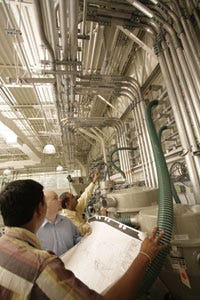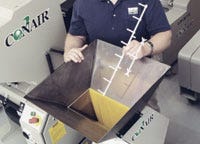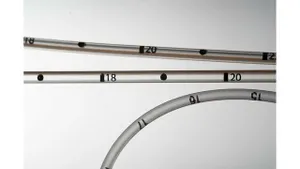Managing materials efficiently
With raw material a molder’s biggest expense, maximizing its management is the best opportunity for processors to save money, boost margins, reduce scrap, and increase yield and uptime.
March 10, 2009
With raw material a molder’s biggest expense, maximizing its management is the best opportunity for processors to save money, boost margins, reduce scrap, and increase yield and uptime.
The buzz surrounding sustainability might seem a fairly recent phenomenon, but the pattern of three arrows appearing on the bottom of recyclable products is something with which consumers, and especially plastic processors, are very familiar. We’re also quite aware of the phrase “reduce, reuse, recycle” that this symbol represents, but usually apply it only to the use of consumer goods.
|
With fluctuating energy and transportation costs and material production capacities, it’s becoming increasingly difficult to find the best deal on material expenses. But processors can make the most of their materials expenditures, first of all with educated purchasing, and then by setting and meeting goals to reduce contamination, material consumption, and pellet loss; reuse drying energy and scrap; and recycle scrap and postconsumer materials back into new products.
Educated sourcing and offsets
Before purchasing expensive equipment, every molder examines the market and researches all available options. Do the same with materials purchasing, bearing in mind that keeping track of all the sources and market variables is a daunting and difficult task.
“Knowing where the market is going in the next 30, 60, and 90 days is critical when it comes to commodities,” says Greg Smith, global business director of engineering resins/PVC/PS for Resin Technology Inc. (RTi, Fort Worth, TX). “The other thing that’s critical is knowing where the market pricing really is, where the best pricing is for the quantities you’re purchasing, and to have enough sources. Never being sole-sourced and having multiple sources gives you better security of supply and the ability to negotiate a better price.”
There is also the option to replace higher-priced materials with less expensive grades. Smith says he has seen an increase in customers asking for offsets, generally for engineered materials such as nylons, PC, and ABS. The shrinking domestic supply base in nylon and ABS, along with PC in North America, creates the need to look into other materials, as does situations in which certain materials have been discontinued. So far, Smith hasn’t seen a significant shortage of any materials because demand is poor, but suppliers are reducing capacity, which in some cases could lead to certain grades being unavailable.
There may be the perception that the services provided by consulting companies like RTi are geared only toward larger molding operations, but RTi says it can also help save on materials purchasing for companies buying in the 3 million-tons/year range. To aid these small to midsized molders, RTi created a fixed-fee program instead of working off a percentage of the material savings, as it does with larger operations. In a difficult economy, this helps smaller processors by removing another variable in its expenses, while still saving on materials and receiving the latest market information. Among the companies using this service are two well-known members of MAPP, the Manufacturer’s Assn. for Plastics Processors.
With global transportation prices affected by unpredictable energy prices, local, upstream integration for new projects should be a clear priority. But in some cases, according to RTi’s Smith, the best deal might not be from a domestic source. “You have enough options, and you certainly have the ability to control your pricing because you are able to create more competition” if you look globally for supply sources, he says. “And in some cases, there’s been a benefit to importing certain resins, like PC and ABS. With nylon, it’s more about utilizing all of the domestic sources outside of the producers, such as compounders – companies who are certainly capable of making the right materials.”
Reduce contamination, variance, and work
While many processors in markets like medical molding are limited in their ability to run in-process scrap or postconsumer recycled resin, there are still ways to help ensure the largest possible reduction of scrap and rejected parts. Although molders can add colors and other additives to materials at press side, it can be difficult to ensure that the ratios are correct, and that the material is properly blended and dried. In medical molding, this task can be even harder due to the need for ultraclean materials. Compounders can create customized materials for any application, which can add up to big savings.
“As a global compounder of custom engineered thermoplastic, our customers continue to challenge us to be at the forefront of many technologies,” says Gregg Newby, global director of marketing and business development at RTP Co. (Winona, MN). “One common theme we hear from many markets is the desire for clean compounds. Tighter control over the environment and specifications during manufacture results in more consistent compounds and eliminates sources of contamination.”
True, initial demand for clean materials has primarily been driven by the medical and electronics industries, but applications requiring improved cleanliness are spreading quickly to other sectors where the cost of contamination in rejected parts is extremely high. In response to its customers’ desire for clean compounds, RTP recently established an Ultra Clean Compounds Center to manufacture materials for applications with higher quality requirements. The 3300-ft2 self-contained, climate-controlled, positive-pressure production environment is currently operational with two extrusion lines, has the capacity for four, and can produce almost any product in the company’s portfolio.
Extruders are fully automated with touch-screen controls that allow complete process monitoring and data acquisition. “Compounds produced in our new facility are also ideal for applications that require extensive data recording and robust traceability of the manufacturing process,” adds Newby.
Reduce colorant and material consumption
Colorants, whether masterbatch or any other form, are often overdosed, and using too much isn’t terribly obvious, as is using too little. But color buildup can lead to high purging costs and increased downtime.
Ampacet Corp. (Tarrytown, NY) introduced SmartColor colorant masterbatches to help reduce costs and material waste. New technology in the self-contained custom masterbatch is said to retard problematic pigments from attaching to screws and barrels, keeping them clean between batches, and thus reducing manual cleaning and purging costs. The company reports that users experience 20-60% faster changeover times, further reducing processing costs.
As the demand for biopolymers in consumer goods and packaging increases, so will the need for renewable, all-natural colors and additives. Based on natural materials like flowers, the new Renol-natur color masterbatches and Cesa-natur additive masterbatches from Clariant Masterbatches (Holden, MA) are among the first commercial color and additive masterbatches that are all-natural and made entirely from sustainable resources.
“While sustainable biopolymers have been used mainly in packaging applications, manufacturers of such consumer devices as phones, personal music players, and laptops are also very interested,” says Stephan Duckworth, global head of consumer goods for Clariant Masterbatches.
In addition to developing colorants and additives, Clariant offers processors a way to reduce the material used in a given product by at least 10%. Chemical foaming agents like the company’s Hydrocerol can reduce part weight, which reduces shipping costs, with minimal loss of physical or mechanical performance. These masterbatches produce foam by decomposing to a gas at processing temperatures, expanding the resin to fill out the part. There is the added bonus of a reduction in the melt viscosity of the base resin, allowing for easier mold filling and reduced cooling time, both of which contribute to cycle times up to 8% faster, the company says, raising productivity and lowering energy costs.
Reduce lost pellets and material handling messes
Finding the right pellet at the right price is only part of the equation. Once material arrives at the molding facility, there are several steps to ensure every pellet is made into product. Al Umstead, system sales manager for Conair (Cranberry Twp., PA) offers a few simple solutions to help processors avoid material waste.
Originally developed to keep birds from ingesting pellets left on the ground after unloading, pellet collection trays at railcar unloading sites help protect the environment and guard against material loss. These trays capture any material falling to the ground as conveying hoses are connected and disconnected from railcars.
High-speed conveying of pellets can create thin strands of plastic called angel hair, and this contaminant tends to create blockages in conveying systems. Material can be lost when maintenance personnel open conveying lines to remove blockages, but angel hair traps can be installed to remove contaminants without spillage.
“To prevent creation of angel hair, keep blower pressures down to about 6-8 psi when using positive-pressure conveying, and keep vacuum line rates between 3800 and 4400 ft/min when using negative-pressure conveying,” says Umstead.
The same high-velocity conveying that creates angel hair can also cause abrasive wear in the corners of conveying lines, so Umstead believes this is another reason to keep conveying rates within the recommended range. Wear-resistant conveying-line elbows can be designed to keep pellets fully entrained in conveying air so that the pellets are less likely to damage the elbows.
Aside from angel hair contamination, other forms of contamination can be eliminated by simple solutions like keeping gaylords covered at all times and using a flexible cover around the vacuum wand as material is drawn from the gaylord. “When there is a central material handling/conveying system installed, some sort of proofing system should be employed to prevent material from being conveyed to the wrong destination,” says Umstead. “This can be as simple as a system of color-coded line connections, or there are electronic proofing systems that can be installed at the distribution manifold to provide feedback to the conveying system control. If the wrong line is connected to a particular outlet, the system will alarm, preventing contamination.”
With a goal of providing processors with information to achieve zero pellet loss, The Society of the Plastics Industry (Washington, DC) is working with the American Chemistry Council’s Plastics Div. (Arlington, VA) on a revitalized Operation Clean Sweep program. This product stewardship program is designed to help every plastic resin-handling operation implement good housekeeping and pellet containment practices, and has the benefit of decreased slips and falls from spilled pellets or violations of storm water regulations. Spilled pellets that enter storm drains eventually end up in the ocean, posing a threat to marine life.
The program provides information and checklists for plant setup and employee training and participation, and recommends prevention, containment, and cleanup procedures. After a program participant signs a “pledge to prevent resin pellet loss,” it receives a certificate to display, and the company’s name can be added to the list of OCS program partners at www.opcleansweep.org, where you can also download the program information.
Reuse drying energy and resin
Getting the pellets to where they are being processed without loss is a big step, but the material must be properly dried before using, which adds a big energy expense. Novatec (Baltimore, MD) developed a wheel dryer design to help cut energy usage by reusing heated air that returns to the dryer from the hopper. The InteliPET is said to use 40-50% less energy than conventional systems based on dual-desiccant-bed dryers. When the heated air leaves the hopper, it is split into two streams, with one portion cooled before passing through the desiccant and the other requiring minimal heating before entering the upper zone. Readings from 11 thermocouples can be automatically optimized without operator intervention, which saves even more energy.
Reusing resin is another area gaining ground. “For OEMs, using more scrap and postconsumer recyclate [PCR] can be economically beneficial as retailers like Wal-Mart, and consumers too, begin looking more favorably at products that have a higher PCR content,” says Gary Hovis, commercial manager of blenders and feeders for Conair. “In most applications, molders can replace 10 – and often more – of virgin material with regrind, without compromising product performance or incurring additional labor costs.” In order to effectively use regrind, molders need to optimize granulator performance and properly blend the in-process scrap or PCR with virgin material.
Mike Verner, Conair granulator sales manager, says that although most injection molders regrind and reuse scrap to some degree, “paying better attention to how they do it can pay big dividends by cutting the amount of virgin material consumed and limiting the amount of material going into landfills.” Make sure the granulator used is designed to handle the kind of scrap being fed into it. This ensures a better-quality regrind that is more readily returned to the molding process, either in-house or by selling through a broker to another processor. “If it is being sold, better-quality regrind will command a higher price,” Verner adds.
In addition to press-side or central granulators, Verner recommends molders consider installing a combination shredder/granulator. For processors who occasionally generate purgings that are too large for a conventional press-side granulator, a moderately priced low-volume shredder/granulator is ideal, and it adds conventional grinding capacity for when a gaylord full of runners and scrap parts needs to be reclaimed.
“Automatic conveying systems reduce labor cost and prevent losses and contamination,” says Verner, “but it is nearly always better to use a negative-pressure vacuum conveying system instead of a positive-pressure blower system. The blower impeller can break up material, creating a higher volume of fines that cannot be reprocessed as readily.”
After the regrind or PCR makes its way back to the point of reprocessing, Hovis recommends choosing a blender designed to keep all material contained within the housing to avoid spillage. “Gravimetric feeding and blending technology, which ensures accurate proportioning of various ingredients regardless of shape or bulk density, can help minimize consumption of colorants and additives,” says Hovis. “More accurate feeding allows for higher volumes of regrind to be used without compromising end product quality.”
Recycle resins into colorful creations
Coloring PCR can be tricky, with recycled polyolefin plastic, for instance, generally having an overall grayish cast, which can be inconsistent from lot to lot. This makes it difficult to end up with consistent vibrant colors, but there are increasing options to help processors achieve the desired end result.
“If you want to increase the use of PCR in your product, all you really need to do is change your focus and decide early in the design process that one of your first goals is to have a very high level of postconsumer resin in your product,” says Jeff Saeger, Clariant’s head of marketing for North America. “From there you address the colorant opportunities available, and you’ll be pleased to discover that there is a full and diverse range of options, such as PCR sorted by color, that allows Clariant to work with our customers to bring vibrant color and dazzling special effects to products made with any level of PCR up to 100%.”
Applying the reduce/reuse/recycle principle to material purchasing and handling not only is beneficial to the environment, but also can save on processing costs and keep shops running in this tough economy. By doing the market research it takes to be an educated buyer, finding a sourcing partner to help reduce material costs, and examining what can be done to turn every pellet into products, molders can make the most of materials. —[email protected]
WEB EXCLUSIVE
Material market forecast
Keeping track of a fluctuating market can be difficult, so using consulting firms can save a great deal of time, while also saving money through smart sourcing decisions. To predict material prices, it’s essential to track the recent history and projections of the raw material chemical markets. For example, consulting firm Chemical Market Assoc. Inc. (CMAI; Houston, TX) recently completed 2009 world analysis reports for several different polymers, examining capacity, supply, demand, and pricing from 2003-2013. Though there are certainly differences in the forecasting of the polyolefin, nylon, light olefin, and polycarbonate supply chains, one factor remains consistent: Rising energy costs have a significant impact on the upstream energy and commodity prices.
The Middle East and China continue with major capacity expansions in the polyolefin market, with the next wave of new capacity coming onstream between 2009 and 2012. This is expected to create global oversupply conditions, which will drive producer margins back down to historic norms, and eventually below reinvestment levels, predicts CMAI. A massive buildup has increased ethylene capacity by more than 22 million metric tons in the Asia/Pacific region and greater than 13 million tons in the Middle East between 1995 and 2008. By 2015, these regions are predicted to add an additional 41 million metric tons, and that significantly cost-advantaged feedstock base will make ethylene production in the Middle East the most competitive in the world.
Recent roller-coaster pricing for benzene has affected the nylon sector, noting that PA6 uses a greater percentage of benzene as feedstock than does PA66. Nylon’s demand as a compounding feedstock for engineering thermoplastics will see its strongest growth in automotive engineering applications, but growth will be lower than in recent years thanks to advancements in competing materials, high feedstock costs, and the overall downturn in the global economy.
For the PC market, recent extremes in global energy prices have been keenly felt in the cumene/phenol supply chain. Even though CMAI predicts an easing of supply-demand balances for benzene, and to a lesser extent propylene, prices for both of these key raw materials have been at record levels. And the fluctuating supply-demand balances of phenol/acetone create volatile swings in acetone availability and pricing, especially since producing bisphenol-A (BPA) requires proportionately more phenol than acetone, creating an increasing oversupply of acetone. Since BPA in polycarbonate has come under attack, this has a negative impact on demand in this sector. Also, since about a quarter of the global PC market is in optical media, which is battling the increasing efficiencies of hard drives, there is a predicted decrease of about 16% in PC demand from this market by 2012. —[email protected]
About the Author(s)
You May Also Like





